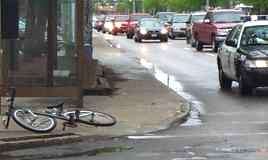
|
Club Member Spotlight - Wei Sun and Fred Oswald, LCI #947 (reprinted) Defeated Nemesis Sierra Road, the Serpent to the East, Bicycle Blunders and Smarter Solutions (sections 1-3)
The great obstacle to progress is not ignorance, but the illusion of knowledge. This illustrated article discusses common blunders (serious mistakes) related to bicycle use, education, advocacy, engineering, and traffic laws. The blunders make cycling more difficult and dangerous and they jeopardize our right to use the roads. The article then suggests Smarter Solutions to avoid these blunders. Footnote [1] Forester's estimate is based on his analysis of Cross, Kenneth D., and Fisher, Gary, A Study of Bicycle/Motor Vehicle Accidents: Identification of Problem Types and Countermeasure Approaches, National Highway Traffic Safety Administration, 1977. The "bike safety" errors that lead to crashes include (1) making a left turn from the right side of the road after signaling but not looking for traffic, (2) weaving between parked cars in order to ride as close as possible to the curb, and (3) stopping at intersections but not looking and yielding to traffic that has the right of way. Traditional bike safety often emphasizes less important requirements (like signaling and stopping) but ignores essential skills that actually prevent crashes (like yielding to traffic that has right of way.) Traditional bike safety teaches that the greatest duty is staying out of the way, even though this often comprimises safety. You can read this article in different ways: (1) As a 27 page pdf file (useful for printing the entire article); (2) By following "Next" links to the various sections; or (3) You can go directly to any section via the links below. The individual sections of this article are updated fairly frequently. The pdf version is updated less often. The author appreciates suggestions, new photos and links to relevant information Links to individual sections
The public impression of bicycles is they are that they are toys to be used carelessly by children. Those adults who use bicycles are regarded as "playing in the road" and getting in the way of more important people who drive cars. The principle safety hazard to cyclists is thought to be traffic passing from behind (the "fear from the rear"). Actual studies of cyclists' crashes show that almost all collisions occur at intersections -- the same as for motor traffic. Hit from behind crashes are extremely rare, except at night when unlit cyclists and intoxicated drivers make these crashes more likely. Bikeways are often promoted to encourage non-cyclists to use bicycles in the belief that separate facilities make cycling safe for people who ride dangerously. They are also promoted because they make people feel safer, even though the bikeways actually introduce new and unexpected hazards. In subsequent sections of this article, we will examine blunders in teaching, use, promotion and accommodation of bicycles and the hazards these blunders create. Then we show Smarter Solutions to avoid the blunders by understanding the principles of cycling. 2. Blunders in Teaching
"Bike Safety" is typically taught by well-meaning but uninformed authority figures (parents, school teachers or "Officer Friendly"). The teaching generally consists of repeating advice that sounds good -- but it is often wrong. Some of this advice is intended to give children a "good scare" so they will stay out of the way of cars. Unfortunately, fear of traffic leads to dangerous mistakes on the road and it makes learning safer methods much more difficult. Almost everyone knows to operate motor vehicles according to a uniform set of rules of the road. We realize that if drivers operated according to conflicting rules they would be likely to drive into each other. But this knowledge does not extend to bicycle operation. Analysis of car-bike collisions demonstrates that over half of them are caused by the cyclist failing to obey the standard principles of traffic operation [1].
Compare bike safety teaching from untrained and uninformed authority figures to swimming lessons given by a certified Red Cross instructor. A Red Cross instructor candidate must be a proficient swimmer, passing both a written and swimming test to get into the 36 hour instructor class. The class includes several teaching skills to be mastered, ending with another written and swimming test. Finally Red Cross instructors work from a carefully prepared syllabus rather than making up advice as they go. In a swim class, children are taught to relax and not to fear the water [2] in order to swim effectively. Another common blunder involves over-emphasizing a minor skill and then ignoring the really important information. Children are taught to signal turns as though it is a religious duty. But they are not taught to look for and yield to any traffic that has the right of way. You can see an example of this blunder in the otherwise rather good (but bizarre) 1963 'bicycle safety' video One Got Fat. Notice in the first of several simulated "crashes", the message seems to be that giving a signal overrides traffic rules, or "It's OK to swerve in front of traffic so long as you signal first." While it is doubtful the producer intended to encourage swerving without looking, this is certainly a bicycle blunder. You can read more about teaching blunders and how to avoid them in Let's Stop Miseducating Society About Cycling. Footnotes [1] John Forester presents an extensive analysis of bicycle crashes in his book Bicycle Transportation, MIT Press, 1994. |
||||||||||
